PUT YOUR WALLET DOWN YOU DON'T NEED TO SIGN UP FOR SOME SKEEVY ASS "ACADEMY", THIS KNOWLEDGE SHOULD BE FREE.
Alright, so I checked in with the Big Boss Tom Fulp due to recent events and got his okay for this, so I'll be teaching you how to get into bitcoin. No, you're not buying anything, and no, you're not getting over 9000 Bugatti's. All you're getting is a public tip jar that anyone can review and see exactly what you're earning and spending on.
https://www.blockchain.com/explorer
That's right. Bitcoin's blockchain (the record of transactions) is public for anyone to peruse and review. Personally, I think it's great for charities and such because it makes stealing donations a whole lot harder because of the digital paper trail that everyone has access to.
THE BASICS.
So, first things first, you're g-PUT THAT STACK OF GPUS BACK WHERE YA FOUND 'EM, WE'RE NOT BUYING ANYTHING LIKE THAT EITHER. Yeap, you can use bitcoin WITHOUT causing problems in the supply of graphics cards AND without getting an electricity bill that'll make you go HNNNNNNNNNNNGHH.
Shocking, right? The shitty influencers didn't want this info getting out...
Anyway, the first thing you want to do is get a bitcoin wallet. A Bitcoin Wallet is software that helps you secure a bitcoin address by combining advanced cryptographic techniques, a secure password and a mnemonic phrase, a list of human readable words.
This sequence of words, along with the password you make, are the key to accessing the funds in your bitcoin address. Let's take a moment to review some bitcoin wallet- hang on, some instagram influencer is on my yard saying I destroyed his graphics card scalping profits with this tutorial.
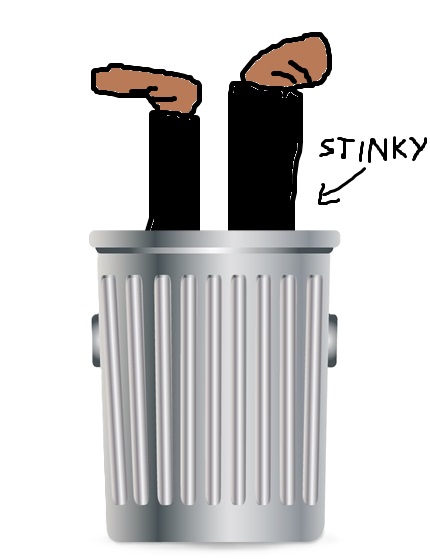
I'm back. Anyway, bitcoin wallets.
(Rocky theme plays)
The Wallet Contenders (Computer Circuit)
First off, we have the original Bitcoin Wallet - often called the Satoshi Client for being the first implementation of bitcoin's wallet system. With years of development and an open-source code for anyone to audit, this venerable piece of software is for those power users who want to get right into the most secure option when it comes to utilizing bitcoin.
Be advised that it downloads the full bitcoin blockchain onto your local system to ensure that no one can intercept your transactions - weighting in at a hefty 500+Gb download and around 5~10Gb per month, but you can enable blockchain pruning to keep the download at a fraction (around 10Gb) while sacrificing little to no security.
Make sure you've got enough space and bandwidth to spare.
-
Secondly, we have a newer MIT-license wallet named Electrum. A lot more lightweight option for people who don't have beefy storage and bandwidth to spare, this wallet uses third-party blockchains to verify your transactions. As you can tell, not having to download the blockchain makes it easier for first-timers to dabble in bitcoin without having to worry about bandwidth and storage space.
Just so you know, that third-party blockchain records can go down (as is with many things on the internet), but for absolute beginners just learning how to use bitcoin, Electrum is an excellent choice for learning how to make transactions, receiving tips and when you're ready for the big leagues, you can export your wallet for use with any other bitcoin wallet software.
There's some more advanced bitcoin wallets out there - but this is a basic tutorial. You came here for a basic understanding, not for a technical lecture.... right?
The Wallet Contenders (Mobile Circuit)
If you're using a smartphone, you obviously can't use software that's built for computers. Smartphone software developers have made some good-lookin' wallets as well. Since I don't actually have a smartphone, all I can do is provide you with some links to android and iphone app pages. It goes without saying, but please read through the reviews posted before using any software here.
Your first bitcoin address.
Remember the mnemonic phrase I mentioned earlier? It's part of an encryption process to introduce complexity and randomness into the process of obfusicating your private keys. Like having a long password rather than a short phrase of alphanumerics. Y'know, like
I-put-an-acorn-in-th3-fridge,but-now-its-an-oak-tree!.Send-help!
is a more secure password than
ABC123!@#
It's time for the moment you've been waiting for! Things are different for each software, but for the sake of this tutorial, we'll be walking through Electrum for the desktop. For the purposes of this tutorial, we'll start with the first option - a simple wallet.
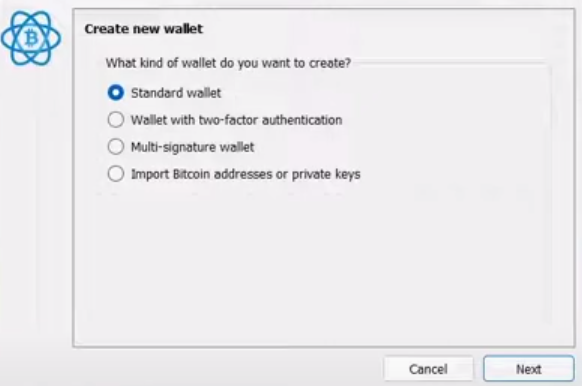
2FA wallets and multi-sig wallets are for extra security and multiple signatures (think joint accounts) respectively.
As you progress, you'll be prompted to take note of your mnemonic phrase and password.
An example of a mnemonic seed on Electrum:
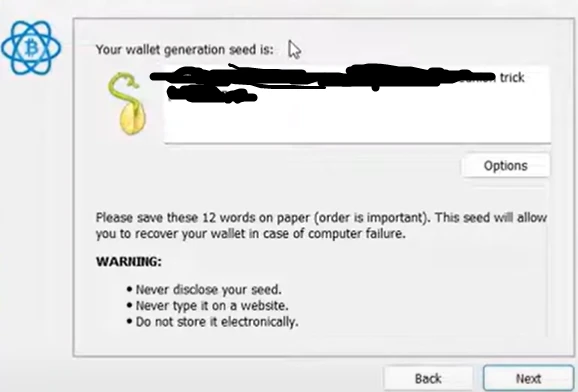
NOTE: 12 words is the minimum, but I recommend 24 word based mnemonic phrases for maximum security. In Electrum, you should be able to generate extra words by clicking Options over there.
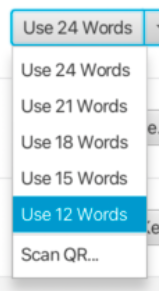
Illustration: Options for wallet generation (this is on one of those advanced wallets I mentioned, but you get the idea).
Your wallet software will then give you the option of creating a password.
Along with the Mnemonic Phrase, this password is one of two keys to secure your new bitcoin address. Follow password security standards to make an excellent password, then write down the Mnemonic phrases in the order that they were generated in, along with your password...
...like this.
- WORD1
- WORD2
- WORD3
And so on
It is important for the Mnemonic Phrase to be written exactly as it is generated. Losing these word sequences is the number one reason why people lose access to their cryptocurrency wallet.
At any point, if you're asked to select between TESTNET and MAINNET, pick MAINNET.
Testnet is a separate blockchain where beta features on the Satoshi client (and some other wallets) were tested with bitcoin that does not exist. This can also be useful to a complete newbie who wants to try their hand at practice transactions without risking real bitcoin. Think of Testnet as the expired credit cards you give to the li'l kid next door who wants them because the cards look cool.
The wallet software will handle encryption tasks and you'll have a nice bitcoin address. If your wallet needs to do any more syncing with the blockchain, let it do the work while you go and stash the mnemonic phrase and password somewhere safe. Preferably in a safe. Like it was a land deed to the Flying Dutchman's Lost Gold mine.
Example BTC address:
1Befii32Bq5AYRh6KmkRQ3zH7U6hm3DiVx
Now, just because your mnemonic phrase and password is NOT anywhere online/digital doesn't mean you're safe from getting hit yet. There's one last concept you need to understand before you post your bitcoin address and start accepting payments - one that came into existence quite recently.
Personal Safety
Bitcoin, due to how it's built, allows anyone to see how much money is on any address at any time. If the account you post your bitcoin address has any kind of personally identifiable info (your mug, home address, drivers license - etc), your bitcoin address can be tied directly to you, and lowlifes and other scumbags looking for a quick payout might try to jump you.
So before you post your freshly-baked bitcoin address, make sure you have followed Ye Olde Internets Safety Standard found in any children's IT books from the late 90s to the early 2000s - no real names, no face reveals, don't give your ID and/or phone number to strangers on the internet.
All that good stuff.

The world's yer oyster!
Now for the good stuff! You can earn and spend bitcoins without worrying about what Collective Shart, Poopypal and Wussa thinks of your works.
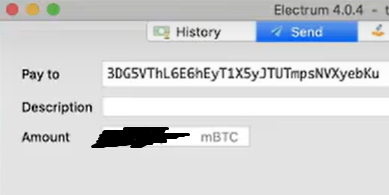
People sending you BTC can add in a description in the transaction, for example, if they're paying for a commission, they can add "payment for super 3D adventure guy art commission". You can review all incoming transmissions and coordinate with your clients to make sure you're collecting what needs to be collected.
Here's a good tip when you're accepting payments in BTC - offer a discount! For example, if you're commissioning a 5$ art piece, accept 4.50US$ in BTC.
So... what's with the fees?
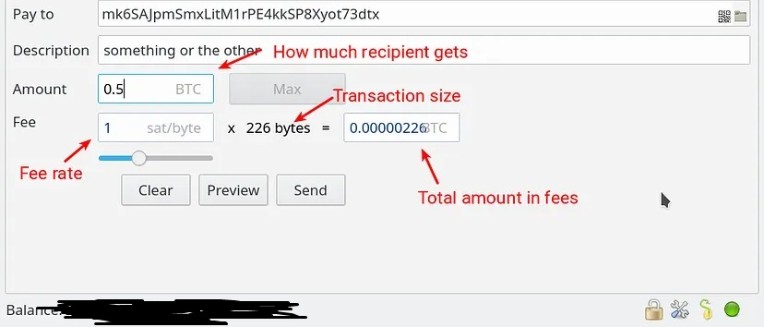
Oh yeah, fees are a thing. The 'cost' to write to thousands of bitcoin ledgers distributed around the world.
Fees in proper wallets should be less than a 1/10000th of the total transaction amount, charged in Satoshis (think cents for bitcoin). The less fees you pay, the slower your transactions go through. Me, I keep mine on the lowest possible rate because my inner circle of TRUE NAKAMA don't mind a slow transaction. It helps keep fees low, too.
Any proper wallet should have the means to alter the fee rate.
Here's Bitcoin Core's take on it.

Fees fluctuate depending on how much writing the blockchain is going through, so a delay of 8 hours is no problem for me. Make sure to keep those fees low to help you save money!
Summary
Step 1: Get a bitcoin wallet software for your device.
Step 2: Make sure your system and bandwidth can handle what you're using.
Step 3: When in doubt, use lightweight systems.
Step 4: Generate the bitcoin address and stash the mnemonic phrase and any password like you've got a land deed to a stretch of mountainous terrain with pure gold veins running through the rock.
Step 5: Before posting your bitcoin address anywhere, make sure you don't have any personal info linked to whatever account you post it from.
Step 6: SKEWER THE WINGED B-uh I mean... All done!
BONUS: A list of scams and what to expect from them.
Rug Pull: Scammers artificially inflate the price of a shitcoin (one they probably made) by spreading false or misleading information. They convince victims to swap their Bitcoin with the worthless shitcoins as a 'trade', then sell their holdings and runs off with the money. This tactic is often used by 'tech bros' to swindle their targets. Remember the $HAWK disaster? Classic rug pull.
Moral of the story: What you have is valuable. Don't throw it away for supposed 'profits'!.
-
Pyramid schemes: This scam relies on recruiting new members to generate profits. Each new member is required to make an "investment", and a portion of this investment is used to pay returns to earlier members. The scheme collapses when there are not enough new members to sustain the payments. The ancient egyptians should sue these "influencers" pulling that kind of scam.
Moral of the story: If someone pitches a 'buy shares to join a profitable BTC venture!!' offer at you - RUN!
-
Social Engineering: This dirty trick involves manipulating individuals into divulging the mnemonic phrase and password. Scammers often pose as customer support representatives, tech experts, law enforcement and so on and steal their bitcoin once their mark cracks under pressure. This usually happens to people whose bitcoin address has been tied to their real identity, but random 'dragnet' attacks have also been reported.
Moral of the story: Record all scammers and push them until they start screaming into the mic. This helps stabilize the planet's magnetic field (source: trust me bro).
-
Fake Bitcoin Wallets: Scammers create fake bitcoin wallets that appear legitimate but are designed to steal the user's private keys or funds. These wallets are promoted through phishing emails, google play store/apple app store, social media or fake websites. Once the user enters their private key or transfers funds, the scammers gain control of the bitcoin. Or in some cases, suddenly charge huge fees to drain your BTC wallet while you least suspect it.
Moral of the story: Check the URL of the website you're on. Fakes can be spotted with a little inspection. Also, use the original developer's site to download your software! Also, use SHA-256 verification to make sure you have an untampered program!
-
Testnet Scam: This dirty trick involves edited photos / a large sum of testnet BTC deposited into a testnet wallet made to look like a real wallet containing an eye-catching amount of BTC. In the real world, testnet BTC isn't really worth anything because faucet services readily provide testnet BTC to developers and hobbyists. The falsified wallet's Mnemonic Phrase and password is offered for sale at a 'reasonable amount' of real BTC, with the customer 'paying' for the right to make a large amount of money... that doesn't really exist.
Moral of the story: If someone offers such a deal to you, ask for and look up the BTC address with a blockchain explorer! Or better yet, demand to see uncropped photos of said wallet. This alone causes the entire scam to implode!
-----------
BONUS: FAQ
Q: What is a seed phrase?
A: The British version of the mnemonic phrase.
Q: Do you use bitcoin?
A: Around 10% of my cryptocurrency portfolio is bitcoin.
Q: WHAT YOU SAY?! BITCOIN IS NOT ANONYMOUS!?
A: Yeap! Take a look at the transaction records of that example bitcoin address I posted.
Q: MINING BAD. DO I HAVE TO MINE?!
A: Just use bitcoin as a tip jar, and/or accept payments in bitcoin. Oh and plant more trees IRL.
Q: So... no mining?
A: No mining.
Q: BITCOIN IS FAKE MONEY! YOU CAN'T USE IT FOR ANYTHING!
Q: I WANT A BUGATTI. WHERE IS MY BUGATTI!?
A: There is no Bugatti. You've been bamboozled!
Q: ...So where's the NFTs?
A: You can get THE BEST NFT right here, FOR FREE!
Q: This is nice, but is there a way to streamline the payment system even further?
A: Sure is! Check this service out. Bit of a technical read, mind you - but it's great once you get it rolling.
Got questions? Need clarifications? Wanna send fan mail? Wanna send hate mail? It's all good - comment on this newspoast and I'll do my best to reply!